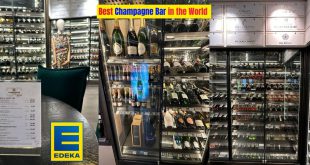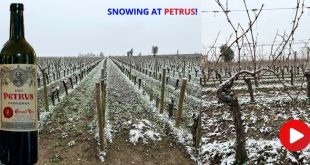
The soil at Pontet-Canet is mainly gravel and sand over clay and limestone. The 81 ha vineyard is planted to 60% cabernet sauvignon, 33% merlot, 5% cabernet franc and 2% petit verdot. The average age of the vines is 35 years.
On 17 January 2020, I attended a dinner in Singapore hosted by Bottles & Bottles. The company was offering Pontet-Canet in a 6-vintage pack from the chateau.
They are: 2013 • 2012 •2011 • 2010 • 2009 • 2008. The Pauillac estate was certified completely biodynamic with the 2010 vintage.
The big change at Chateau Pontet-Canet took place in 1989 when Jean-Michel Comme joined as estate manager and became in charge of winemaking.
Comme’s greatest contribution was to persuade his new employer to go biodynamic. I remember proprietor Alfred Tesseron saying this to me a few years ago.
‘There was no point trying such a radical change over a little corner of vines. So I told him to go for it because I trusted his expertise and his belief in the system.’
Alfred Tesseron’s instincts and bold decision was a coup. Considered a champion of biodynamics, Pontet-Canet is today immediately associated with this extreme form of viticulture in which one works in tandem with the natural rhythm of Nature. Complete with all the attendant rewards and risks it entails.

‘There was no point trying such a radical change over a little corner of vines. So I told him to go for it because I trusted his expertise and his belief in the system,’ Alfred Tesseron with one of the horses used to plough the biodynamic vineyard.
‘We started in 2004 and by 2005, 30% of the vineyard was biodynamic. Progressively, we increased the percentage and was certified 100% biodynamic in 2010. The goal has always been to increase the quality of the wine,’ Tesseron revealed.
While there are risks involved in embracing biodynamics since there are treatments which are not allowed if you follow the stringent regime, the benefits can be very rewarding.
‘In biodynamics, you have to prepare harder before problems happen. For example, when mildew strikes, it’s already too late. We are, therefore, always working to prevent problems. We take more care of the vineyard and make more observations, to translate those observations in order to understand – and give a balance and equilibrium to – the vineyard.’
To plough the large, single plot 81 ha vineyard, there is a stable of some 10 horses. They walk slowly, steadily to ensure the earth they walk upon between rows of vines does not become compacted (as would be the case if a tractor is employed). Instead, the ground continues to breathe and live.
Whether owners or employees, there is a lot of evident pride at Pontet-Canet in what they are doing. One of the biggest challenges for a chateau deciding to switch to biodynamic viticulture is to convince the entire team – from vineyard workers to cellar hands – to come on board the same journey of discovery. Old habits are not always easy to change.
At Pontet-Canet it has been one hell of a ride. Entirely upwards. Perhaps even defying gravity. Certainly as far as prices are concerned. Although given a fifth ranking in the 1855 Classification, Pontet-Canet fetches prices closer to a Second Growth. The switch to biodynamics has made Chateau Pontet-Canet one of the most dynamic estates in the whole of Bordeaux.
Chateau Pontet-Canet was acquired by Guy Tesseron (father of Alfred) in 1975. The Tesserons are legendary producers of cognac and have some of the oldest stocks of eaux de vie imaginable. Their customers include the biggest brands who rely on what they have squirrelled away in the Tesseron Paradis from another time. The Tesserons have been distilling the spirit for 500 years. Cognac Tesseron is a high flier. It is a regular feature on Air France and their lounges.

Tasting Notes
Chateau Pontet-Canet 2013
The 2013 vintage has been one of the most difficult in modern times. It rained so much with the attendant risk of rot. And dilution. In spite of the uphill challenge, Pontet-Canet has delivered an impressive result given the circumstances. Blackcurrant/cherry fruit with smoky notes from the oak. Quite intense for 2013.
Chateau Pontet-Canet 2012
About a third of the vintage was aged in clay amphorae. Blackcurrant fruit with lots of lift and freshness. And tannins from oak. Ahead of 2013 (as one would expect) and also more intense than 2011.
Chateau Pontet-Canet 2011
Slightly more evolved than 2012, the tell-tale blackcurrant fruit is all there. So too the oak which renders the wine a touch austere on the finish.
Chateau Pontet-Canet 2010
This is the vintage when Pontet-Canet was certified biodynamic. The above three vintages were double-decanted for 1 hr 45 minutes before the tasting/dinner started. Yet, this, 2009 and 2008 were not. They were served straight out of the bottle. Given the richness of 2010 and to a lesser degree 2009 and 2008, they should certainly had been decanted. The black fruit is very tight, taut and dense. Very, very closed.
Chateau Pontet-Canet 2009
The 2009 vintage is always more forward than 2010 which has greater acidity and ageing potential. It was a heatwave in 2009. Blackcurrant, oaky fruit.
Chateau Pontet-Canet 2008
This vintage found it difficult to follow after the richness of 2009. A more classic, lighter year, the acidity is also fresher.


